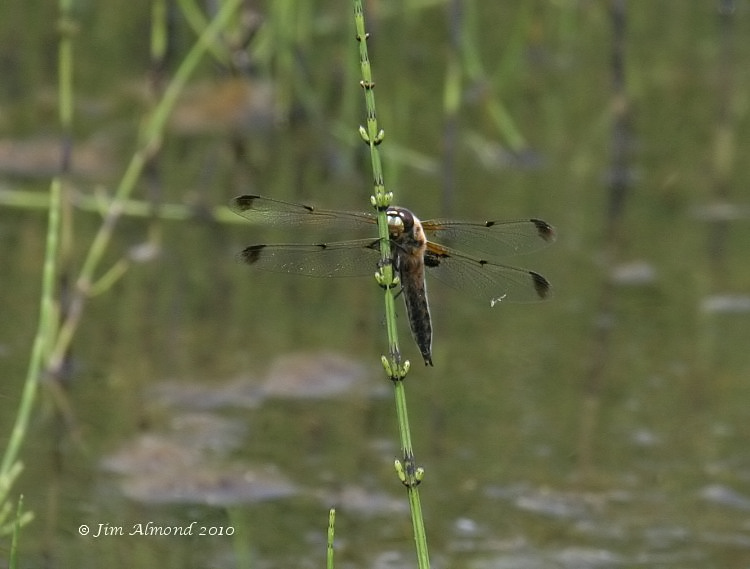Name
Libellula quadrimaculata (Linnaeus, 1758)
Family:
Libellulidae
Status in Britain and Ireland:
common and widespread; irregular migrant
Local Status:
common
Size:
Overall body length 40-48mm
Hindwing length 32-40mm
Flight period:
Mid May to mid August
Photograph © B. Smith
Male Four-spotted Chaser
The body is brown (orange brown when immature). The abdomen is very stout at segment 2 and tapers to a narrow segment 10. The sides are yellow from segment 4-8 and the tip of the abdomen is black. The wing markings are diagnostic with 4 spots clearly visible at the nodes (mid points) of the wings. These are in addition to the dark pterostigma. The hind wings also have dark patches at the base – a feature characteristic of all chasers. An area of yellow also spreads across the front of the wing. Another form of this species called praenubila is quite commonly seen. Shown in the additional photographs below and in the female photograph, this form has more black at the nodes and an area of black extending from the pterostigma. The eyes are brown and the legs are black.
Photograph © B. Kemp
Female Four-spotted Chaser
The female is virtually identical to the male and most easily distinguished by behaviour if ovipositing or copulating. Failing this, the absence of secondary genitalia will determine a female.
Similar Species
Skimmers are medium sized dragonflies, but have clear wings with no dark basal wing patches. The Broad-bodied Chaser and Scarce Chaser lack the 4 spots on the wings.
Behaviour
Males are fast and aggressive and will view their territory from a selected perch and fly out to chase off other males or to seek a female. Females are grabbed in mid- air and copulation takes place in flight in a matter of seconds. Females then oviposit alone but with the male in attendance to chase off intruding males. The female hovers over the water, usually where there is submerged aquatic vegetation and either dips her abdomen into the water or sometimes flicks the eggs into the water.
Habitat
Found in a wide range of mostly standing water habitats including lakes, ponds and canals and thrives in acidic heathland ponds. Known to be a pioneer species at new sites.
Shropshire Distribution
Historic records date back to 1932 at Whixall Moss with a handful of further records at this site in the 1950’s. During the 1960’s and 70’s sightings were also made at Clarepool Moss, Brown Moss, Bettisfield Moss and Wildmoor Pool- all still recorded sites today. Described by Lockton et al., (1996) as local, this species is now common in Shropshire. The recent National Atlas (Cham et al., 2014) highlighted a significant increase in distribution and this has been seen in Shropshire, particularly toward the north and west of the county. Though found in a wide range of Shropshire standing waters numbers are highest at acidic heathland pools.
Where to see in Shropshire
Pole Cottage Pool and Wildmoor Pool on the Long Mynd, Whixall Moss, Dudmaston, Aston Locks, Brown Moss, Cramer Gutter on Catherton Common.




